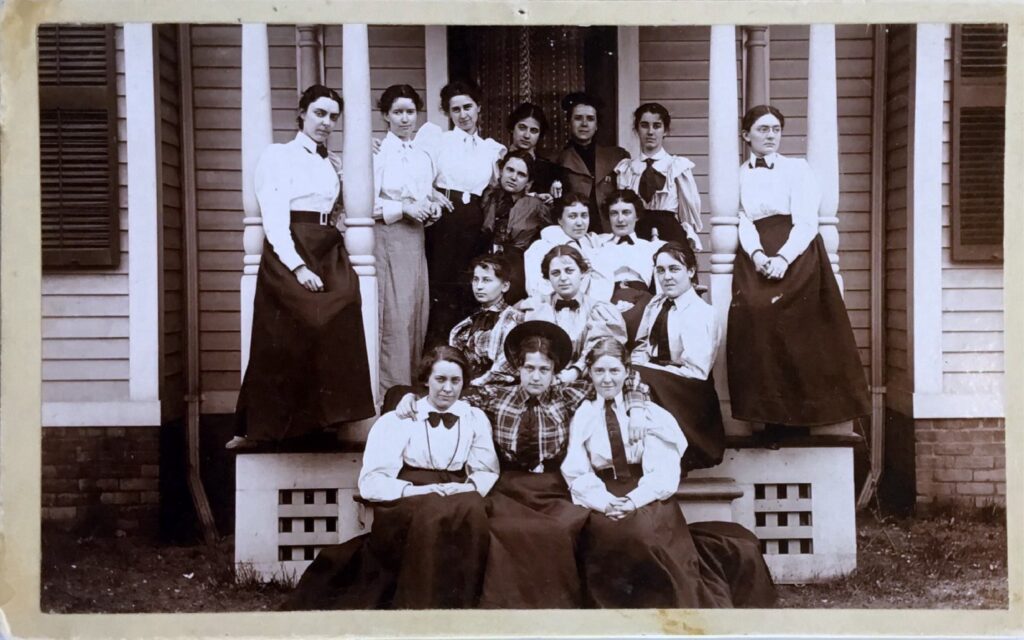Change, Conflict, and Community Over Time

Green Street & Smith’s Changing Relationships and Landscapes
Once a bustling commercial hub where Northampton business shared the patronage of Smithies and community members alike, a “little Greenwich Village”1 with affordable housing and queer businesses, and a beloved Northampton neighborhood, Green Street is now a Smith-owned ghost town, lively primarily where the academic buildings begin.
As the student population at Smith continues to grow, change, and turn over, we lose the memory of what campus looked like before we knew it, and we lose the imagination that comes with that knowledge.
What would a shared space between Smith College and Northampton look like? What would Smith gain as an institution? How would Smithies benefit? How would the Northampton community benefit?
While students, staff, and faculty grasp at community, connection, and third spaces, we often fail to look beyond campus. As we navigate 2025’s campus use polling and strategic planning, it’s essential that we understand why our imagination is so limited, and we think beyond the Smith bubble.
Where better to start than the mixed-used, porous border of Smith College, Green Street?

Ghosts of Green Street
It was a wonderful neighborhood, very lively. We knew everybody. There was the barber shop, a corner store where we got ice cream and candy—you could pretty much do whatever you needed to do right here.”
Linda Gaffney, May 10, 2007.2
Green Street has lived many lives. Explore the image hotspots below to learn more about the history of some familiar buildings.
Discussion Questions:
- Where does Smith College become Northampton? Where does Northampton become Smith College? Are they one in the same?
- What role has Smith taken in regards to Green Street? Do you agree with this choice?
- What do you think about the Ford Hall/community housing conflict? Do you feel like the conclusion of this conflict was the best option?
- What does Smith owe to the Northampton community?
Further Reading
“Space Exploration: Mapping Students’ Perception of the Smith College Campus,” a masters thesis by Stephanie Alexandra Keep. https://scholarworks.smith.edu/theses/1336.
“Space Exploration” includes surveys of students regarding their relationship to different spaces on campus, analysis of campus planning, and a literature review including the subjects of “use of maps, student satisfaction […] and perception of community support” (3). This research is helpful in understanding how Smithies have historically related to their campus, especially in the years surrounding the construction of Ford Hall, and changes to Green Street. This thesis includes figures that represent student preferences and feelings about spots on campus based on surveys from 2002 to 2005.
“Universities and Gentrification: The Effects of Anchor Institution Initiatives on Rates of Neighborhood Change,” an article by Paul M. Garton. https://doi.org/10.1007/s11162-023-09733-y.
This article explores the role of universities in gentrification. Garton writes about the role of universities as anchor institutions—institutions like universities and hospitals that provide consistent and stable capital. As anchor institutions, universities support development plans without necessarily engaging in the community, and are often responsible for gentrification. This article can provide some context to Smith’s role in Northampton, as the school has been accused of gentrifying the town. This is especially helpful for understanding Smith’s destruction of affordable housing and local commercial spaces as part of development plans like the building of Ford Hall, the expansion of student housing, and the general academic use of buildings on Green Street.
Smith College: an Architectural Tour, a book by Margaret Birney Vickery.
Vickery’s guide to the Smith College campus provides helpful context for understanding the campus’s setup, relationship to Northampton, and core design principles. Understanding Smith’s design is essential to understanding its expansion across the 20th century and into the early 2000s, and is a worthy read as Smith seeks input regarding campus use and design. Previous president Carol T. Christ introduces the book; it’s interesting to get a peek into her mind and relationship to the campus, especially in a year when she was a controversial figure.
Further Research
- Martha Ackelsberg papers, Sophia Smith Collection, SSC-MS-00644, Smith College, Northampton, Mass.
- Ackelsberg was a local advocate for affordable housing, and worked on the Smith/Northampton Affordability Partnership (SNAP). Her papers include lots of interesting communications regarding the building of Ford Hall and the housing debate surrounding it.
- Oh No! Noho!, March 1985. https://archive.org/details/oh-no-noho-03-85/mode/2up
- Check out this local alternative publication and its articles about gentrification: “Paradise Lost? The Gentrification of Northampton.” This issue includes interviews with many different community members about the town as its commercial and cultural character shifted in the 1980s.
- Box 209.2, Buildings records, Smith College Archives, CA-MS-00104.
- The first two folders in this box include a wide range of articles about Smith’s purchase of boarding houses on Green Street, then on the building of Ford Hall. This collection of articles is a great resource and a starting point for more research.